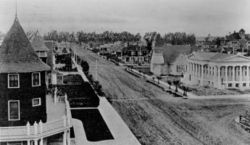Blog, Business, History, Info, Forum, Classified, Photo Album
FREE business/organization listing. Submit your promotional statement (pictures). Your business will be featured for FREE [more]
Ventura County community website created and maintained by your Ventura County neighbor |
Blog, Business, History, Info, Forum, Classified, Photo Album FREE business/organization listing. Submit your promotional statement (pictures). Your business will be featured for FREE [more] |
History of Oxnard
 Before the arrival of Europeans, the area that is now Oxnard was inhabited by Chumash Indians. The first European to encounter the area was Portuguese explorer Juan Rodriguez Cabrillo, who claimed it for Spain in 1542. During the mission period, it was serviced by the Mission San Buenaventura, established in 1782.
Before the arrival of Europeans, the area that is now Oxnard was inhabited by Chumash Indians. The first European to encounter the area was Portuguese explorer Juan Rodriguez Cabrillo, who claimed it for Spain in 1542. During the mission period, it was serviced by the Mission San Buenaventura, established in 1782.
Ranching began to take hold among Californio settlers, who lost their regional influence when California became a U.S. state in 1850. At about the same time, the area was settled by American farmers, who cultivated barley and lima beans
 Henry Oxnard, who operated a successful sugar beet factory with his three brothers (Ben, James, and Robert) in Chino, California, was enticed to build a two-million dollar factory on the plain inland from Port Hueneme shortly after the 1897 beet campaign, a new town soon emerged. Ironically the Oxnard brothers never lived in their namesake city, and they sold both the Chino and the giant red-brick Oxnard factory with its landmark twin smokestacks in 1899 for nearly four-million dollars. The Oxnard factory operated from August 19, 1899 until October 26, 1959. Given the growth of the town of Oxnard, in the spring of 1898, a railroad station was built to service the plant, which attracted a population of Chinese, Japanese, and Mexican laborers and enough commerce to merit the designation of a town. Oxnard intended to name the settlement after the Greek word for "sugar", but frustrated by bureaucracy, named it after himself.
Henry Oxnard, who operated a successful sugar beet factory with his three brothers (Ben, James, and Robert) in Chino, California, was enticed to build a two-million dollar factory on the plain inland from Port Hueneme shortly after the 1897 beet campaign, a new town soon emerged. Ironically the Oxnard brothers never lived in their namesake city, and they sold both the Chino and the giant red-brick Oxnard factory with its landmark twin smokestacks in 1899 for nearly four-million dollars. The Oxnard factory operated from August 19, 1899 until October 26, 1959. Given the growth of the town of Oxnard, in the spring of 1898, a railroad station was built to service the plant, which attracted a population of Chinese, Japanese, and Mexican laborers and enough commerce to merit the designation of a town. Oxnard intended to name the settlement after the Greek word for "sugar", but frustrated by bureaucracy, named it after himself.
 Oxnard was incorporated as a California city on June 30,1903, and the public library was opened in 1907, one of only three built west of the Mississippi river financed by Andrew Carnegie. Prior to and during World War II, the naval bases of Point Mugu and Port Hueneme were established in the area to take advantage of the only major navigable port on California's coast between the Port of Los Angeles and San Francisco Bay, and these encouraged the development of the defense-based aerospace and communications industries.
Oxnard was incorporated as a California city on June 30,1903, and the public library was opened in 1907, one of only three built west of the Mississippi river financed by Andrew Carnegie. Prior to and during World War II, the naval bases of Point Mugu and Port Hueneme were established in the area to take advantage of the only major navigable port on California's coast between the Port of Los Angeles and San Francisco Bay, and these encouraged the development of the defense-based aerospace and communications industries.
In the mid-century Oxnard grew and developed the areas outside the downtown with homes, industry, retail, and a new harbor named Channel Islands Harbor. Martin V. ("Bud") Smith (1916-2001) became the most influential developer in the history of Oxnard during this time. Smith's first enterprise in 1941 was the Colonial House Restaurant (demolished 1988) and then the Wagon Wheel Junction in 1947. He was also involved in the development of the high-rise towers at the Topa Financial Plaza, the Channel Islands Harbor, Casa Sirena Resort, the Esplanade Shopping Mall, Fisherman's Wharf, the Carriage Square Shopping Center, the Maritime Museum, and a plethora of hotel and restaurant projects.
During the 1950s, a phenomenon know as white flight was commonplace in Southern California, and Oxnard was no exception. With the rise of the local defense industry and other high tech and financial industries, the more educated, predominantly Caucasian and Asian-American "white-collar" professional class moved from the older city core to the newer, more suburban neighborhoods either to the north, south, or west. Subsequently, the less educated, predominantly Hispanic and African American "blue-collar" working class populated the more affordable areas in the city center, particularly the La Colonia Barrio just east of Downtown Oxnard. The poverty and neglect in these neighborhoods gave rise to gangs such as the infamous "Colonia Chiques," and violence continues to this day over turf disputes between rival gangs.
-
Section Menu